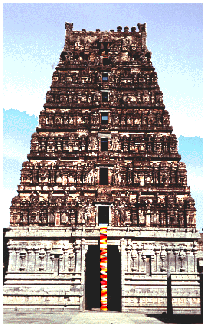 We are today in Madurai, the ancient town, the axis
of which is a temple, the famous Meenakshi Temple. I am very happy
as my speech will also
be based on temples. But I am also very
sorry about my bad English. When I was educated, Italian schools
held the view that Greek and Latin were more important than any
foreign living language. This lack of good English may also be
a luck, because long academic sentences (full of sintax and odd
words) must be avoided. Compelled to be plain, I hope I will be.
We are today in Madurai, the ancient town, the axis
of which is a temple, the famous Meenakshi Temple. I am very happy
as my speech will also
be based on temples. But I am also very
sorry about my bad English. When I was educated, Italian schools
held the view that Greek and Latin were more important than any
foreign living language. This lack of good English may also be
a luck, because long academic sentences (full of sintax and odd
words) must be avoided. Compelled to be plain, I hope I will be.My aim is to resume some general ideas about art and/or handicraft and later to focus them into a single concrete work. The title itself is a homage to Bruno Munari, the italian master of design who, more than 50 years ago, entitled an article of his: "What are unuseful machines and why". If any of you has not heard of Bruno Munari, you can trust Pablo Picasso's quotation: "Bruno Munari is the Leonardo da Vinci of the 20th century".
By the word /design/ we usually mean the work of conceiving and shaping any new object to be manufactured. Though the latin root of the word /manufacture/ was originally related to "hand made" (manu factum), /manufacture/ today means industry, "factory". So that the common meaning of /design/ is "industrial design" (ID): when you meet today some /designer/, he is obviously an "industrial designer". This is his own wishful thinking, anyway.
To be really an industrial designer, you must look carefully at your raw materials and at the way machines are able to cut, press, joint, paint, etc . You may otherwise dream the most wonderful object, you may also nicely draw it on paper: yet you will not be a designer. In the best case you could be an artist, but a designer's is a different work. The artist also has his practical problems: his thinking about a painting, a symphony or a novel is not enough. The real work of art begins when he puts his hands on the brush, the piano or the type-writer (tools that are quite different from any industrial equipment). Nevertheless, it is very easy to find objects "signed" by artists. Sometimes they have also been designers, as they have understood the creative chances of machines. They got otherwise but good business as a testimonial of their signed item, which may be nice to look at, often useless, but never cheap.
All above said is the basic teaching of the Bauhaus school and Bruno Munari's, which is supposed to be the basic lesson in every school of ID.
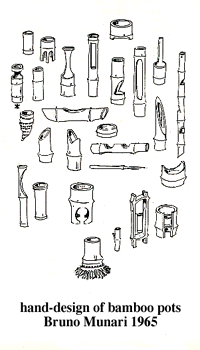 Let's
focus on hand-design (HD). Hand-design is obviously involved in hand-made objects,
in handicraft. So the hand-designer can't ignore the craftsmen's
opinion, he cant't just tell them "make it like my scrap".
In this case, he will be more lucky than the industrial-designer,
for this one can never say of his machines: "they are stupid".
Machines are surely stupid, so that when they don't produce the
supposed object, all the guilt will fall on him as the designer.
Let's
focus on hand-design (HD). Hand-design is obviously involved in hand-made objects,
in handicraft. So the hand-designer can't ignore the craftsmen's
opinion, he cant't just tell them "make it like my scrap".
In this case, he will be more lucky than the industrial-designer,
for this one can never say of his machines: "they are stupid".
Machines are surely stupid, so that when they don't produce the
supposed object, all the guilt will fall on him as the designer.
May be the best hand-designer should be a craftsman himself. But usually craftsmen are so rooted in their tradition that they don't care about creating anything new. On the other side, the designer may also be proud, not of tradition but of his education and his own supposed creativity. The first step of the hand-designer in approaching his craftsmen is not that of teaching something new to them, but on the contrary to learn from them. He has to look very carefully at their acts, tools and works, to make enquiries and so on. He must be so clever to learn the most he can about their operating language, their way of thinking, even about their taboos. if any. You may ask a potter who works with the wheel to make square shapes, but you will save a lot of time if you can find the right new round shape in your creativity.
This may seem a limit, but as Leonardo da Vinci said: "Nature is full of reasons that never were experienced", it can also be said that "Handicraft is full of reasons that never were experienced". Supposing that every handicraft is structured as a language, absolutely new concepts can be built by its own vocabulary and sintax. Of course, only if you can speak this language. This metaphor of communication brings us now to its other side: the reception of the message, i. e. to the market.
This is a great battle: victory seems to be on the side of the factory and the handicraft to be the loser. I like, for example, to remind how many humble tea shops are all red painted with the mark of Coca Cola, though they often sell Pepsi and, mainly, just tea. Nevertheless a painter was here engaged to imitate a printed mark by his brush. Summing up, there are today on one side traditional craftsmen who only repeat their old items, often worsened by a cheap tourist market. There are craftsmen on the other side who are compelled to copy (and badly) factory products. That's because most people are fond of factory products. More so because, they are powerfully pushed by all sorts of media advertisments.
So people are more and more forgetting the language of the handicraft: they can hardly understand its meaning, when they hear it. Under such conditions, the hard task of the hand-designer is to be simple, as his public is mostly uneducated in handicraft as a 1st grade class is in writing: they can but read large capital letters. In such a way of shaping an object, they must recognise the trace of the hand, otherwhise they will perceive no difference between hand-made and factory-made. Worse: they might criticise the hand-made as imperfection.
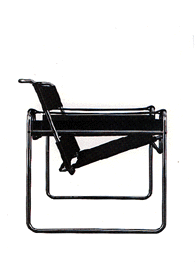 To be simple
in shaping is not to be rough, let's take an example from industrial
design: the famous "Wassili"
armchair by Breuer, architect in the Bauhaus
school (this name "Wassili" was a homage to the painter
Wassili Kandinskij, also teacher at the former Bauhaus). All that
the chair is made of, is a single steel pipe. This cromated pipe
had not been cut or jointed, it had only been plied. After that,
it had not been hidden under any cover, but only 4 large leather
strips were layed and sewn on it, so that you can sit, have a
back rest and also have armrests. Everybody can see the whole
steel pipe and reach the designer's idea applied to this industrial
material, that is different from wood. Wood needs joints, steel
on the contrary can be plied by machine so that it need not care
to copy the traditional shape of a hand-made wooden armchair.
A different beauty was born, it may today seem common, but it
was only 70 years ago when it was a revolution.
To be simple
in shaping is not to be rough, let's take an example from industrial
design: the famous "Wassili"
armchair by Breuer, architect in the Bauhaus
school (this name "Wassili" was a homage to the painter
Wassili Kandinskij, also teacher at the former Bauhaus). All that
the chair is made of, is a single steel pipe. This cromated pipe
had not been cut or jointed, it had only been plied. After that,
it had not been hidden under any cover, but only 4 large leather
strips were layed and sewn on it, so that you can sit, have a
back rest and also have armrests. Everybody can see the whole
steel pipe and reach the designer's idea applied to this industrial
material, that is different from wood. Wood needs joints, steel
on the contrary can be plied by machine so that it need not care
to copy the traditional shape of a hand-made wooden armchair.
A different beauty was born, it may today seem common, but it
was only 70 years ago when it was a revolution.That revolution won (though it seldom reached the same aesthetical level of Breuer); so that today's craftsmen have often to copy machine-shaped objects, just like the above said printed mark of Coke. The task of hand-designers is today to renew that miracle of the intercourse of human body and nature, which is the true spring of every civilisation, and from which are born hand-made products. The human partner cooperates by his mind, his skill, his tools. Nature on her side gives materials that are not merely "raw" and that which you cannot handle if you don't know them and love them.
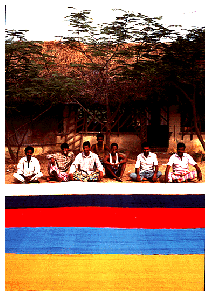 So
that any further remark on this subject would be useless and abstract,
if it were not connected to any concrete kind of material and
of handicraft. It's time to
look closely at hand-weaving and, to this
purpose, let's walk through the useful bridge of a maybe long
quotation from Ananda K. Coomaraswamy's book:
So
that any further remark on this subject would be useless and abstract,
if it were not connected to any concrete kind of material and
of handicraft. It's time to
look closely at hand-weaving and, to this
purpose, let's walk through the useful bridge of a maybe long
quotation from Ananda K. Coomaraswamy's book:Thus the carpet loom is a tool, a contrivance for holding wrap threads at a stretch, for the pile to be woven round by the craftman's fingers; but the power loom is a machine, for it does the essential part of the work, and so doing imposes limitations on the spontaneity and freedom of the design and on the intelligence of the worker. (...) It is essential, then, for a re-union of art and labour, the machinery should be controlled; and this control can be properly exercised by the craftman himself. The place of machinery in a true civilisation will be that of a hewer of wood and drawer of water, a servant, not a master; its concern will be rather with the preparation than with the subsequent manipulation of materials. Its purpose will be, not to rob the craftmen of that part of labour which is his very craft itself, but to save him from the heaviest and least interesting work, and to carry out only the simplest and most mechanical processes of manufacture. It is, of course, true that even in the preparation of materials, and the execution of monotonous labour, the machine is in many cases inferior to the hand. Thus, to take a single example, the hand-woven textile is, ceteris paribus, more durable than the machine woven, owing to the regularity and mechanical character of the strains put upon the threads of the latter; and the surface, even if quite unornamented, is artistically superior. So again, a machine-stamped binding, or a machine planed table, or a lathe-spun bowl, lack the peculiar surface characteristic of each material, and developed by hand work on it; the tecnical perfection of the surface in the one case is simply uninteresting, in the other varied.
Nice bridge, was it not? I hope you all enjoyed. You would not say it's about a century old. By the way, the whole book (Sinhalese Medieval Art):was printed by the Arts & Crafts of William Morris, quite a master in our matters.
Well, we are now in the weaving country. First of all, we will deal with yarn. An educated mind is bent to imagine a thread as a geometrical line. A straight line is infinite, it has neither end nor beginning. A thread must on the contrary always be cut: it is cut in weaving when, for example, a bobbin fills the size of the shuttle. So that, in laying his weft, the weaver goes on with different shuttles.
He can easily weave a striped cloth only by changing the colour of thread in the next bobbin. In this way, he will neither be troubled by measuring by scale the width of each stripe, nor will he have to stop in changing half-empty shuttles. Red bobbin is over? Let's go on with the blue one.
These red/blue stripes will be of course a little different, as all the shuttles cannot be filled by exactly the same amount of yarn. No problem: the trees in a forest are not quite all the same size, nevertheless everybody enjoys admiring the forest. Neither are two leaves quite the same... This is the concept of nature herself: she follows genetic patterns but never creates two individuals exactly the same. We admire in nature's creations her eternal laws and the accidents of life. When a flower seems too perfect, we suppose it's made up of plastic.
This was only the roughest example, but the same basic idea of the red/blue stripes can be easily recognized in the tapestries called "Macroscopies". This name forged from Greek means more or less "zoom" and obviously comes from the above said task of clearly showing (of writing in readable capital letters). In tapestry, you usually put different colours (i. e. threads) into a single weft shed, so that you can build the whole shape row after row, just like a brick wall. In these Macroscopies, you can never find more than two colours-threads in the same row-shed: one is left side colour and the other is right side colour. By the way, this is far more quicker to weave.
A sort of cell-like shape can be found here, like a brick into a wall. I was looking for the simplest shape that could be found in any weaving all around the world. It is a scaled triangle, which in India is called gopuram, as it looks like a stylized temple tower. This concept of the gopuram is used on sari borders from Kanchipuram, known as "temple border saries" and also on sari borders from Andra Pradesh, known as kota kommalu.
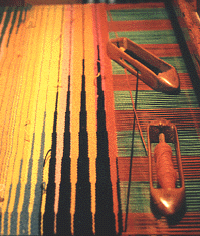
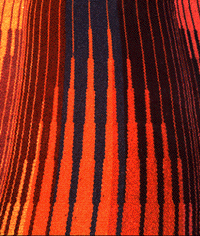
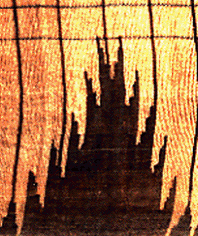
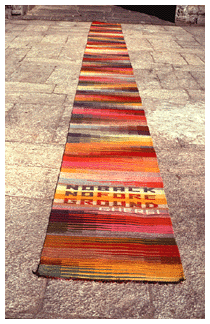 A little must also be
said about the colours. They change whenever a shuttle is empty,
as mentioned in the former example of the red/blue stripes. The
sequel of colours is not planned or drawn on paper in advance.
It happens as in life: you must live it with whatever you get.
You keep nevertheless some rules in your mind, these are in our
case the above said gopuram-shaping laws; laws that are
somehow in keeping with Nature.
A little must also be
said about the colours. They change whenever a shuttle is empty,
as mentioned in the former example of the red/blue stripes. The
sequel of colours is not planned or drawn on paper in advance.
It happens as in life: you must live it with whatever you get.
You keep nevertheless some rules in your mind, these are in our
case the above said gopuram-shaping laws; laws that are
somehow in keeping with Nature.